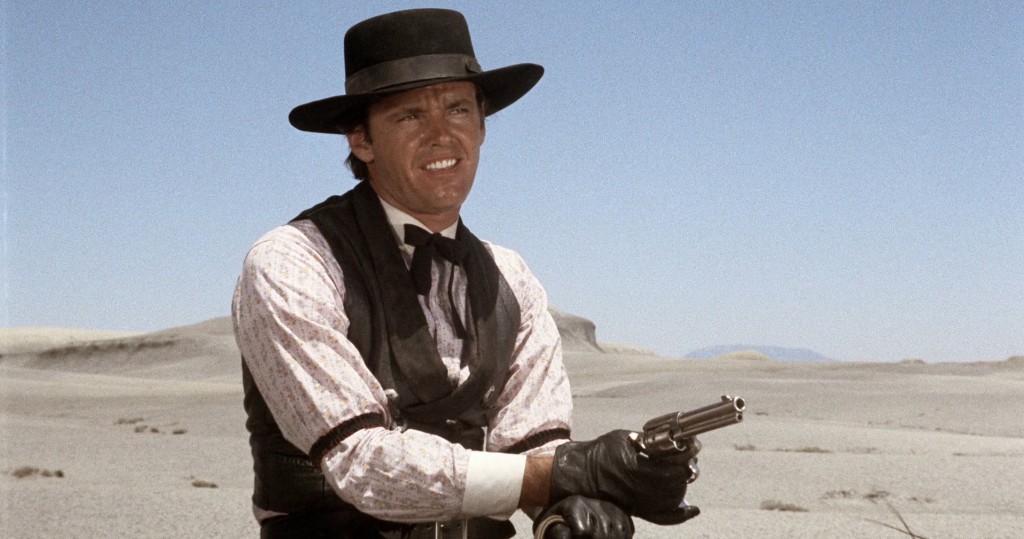By Jude Warne.
The Shooting and Ride in the Whirlwind (both 1966), recently released as a joint Blu-ray set via The Criterion Collection, are two Monte Hellman Westerns that are as nondescript as their titles suggest them to be. And, much like the title of Hellman’s road picture, the Criterion-released Two-Lane Blacktop (1971), these titles are often indicative of what one might encounter over the course of the films’ stories. There is no doubt about it: these are simple movies that seem to aim for artistic weight with their existential hues, but they excel in their manifestations of genre-ness, the Western and the road film. Here in these Westerns though, instead of Two-Lane’s young James Taylor, who delivers one of the most uncharacteristically aggressive utterances ever of his entire artistic career (“Make it three yards, motherfucker, and we’ll have us an automobile race,”) there is a young Jack Nicholson.
This is Jack before he was nominated for an Academy Award for his performance in Easy Rider (1969), a nomination that would be the first of twelve over the next five decades, three of which resulted in wins. This is Jack before he was Bobby Dupea, Billy “Badass” Buddusky, Randle P. McMurphy or Jack Torrance. This is Jack before he was The Movie Star. Nicholson himself penned Ride in the Whirlwind, and while he served as Producer of The Shooting, another BBS Productions regular, the screenwriter Adrien Joyce (pseudonym for Carole Eastman) penned its script. Joyce would soon pen a true career-defining role for Jack in her classic screenplay work on Bob Rafelseon’s Five Easy Pieces (1970). Watching pre-movie-star-Nicholson, one consistently gets the feeling that one is in the presence of an actor who is going to be truly great, an actor who is already truly great but has yet to be provided with the proper opportunity in which to fully channel his greatness.
The entire picture – I’m referring to The Shooting here but this vaguely applies to the other picture as well – is akin to a too-long (though it doesn’t even hit the ninety-minute mark), slightly frustrating, and unnerving dream, like one of Rod Serling’s longer Twilight Zone episodes, minus the entertaining and distinctive voiceovers. There is an edgy score and a creepy, barren landscape of dry, desert dirt and heat, devoid of – well, just devoid, period – and a few characters who spend most of their time getting on each other’s nerves. That said, there is some impressive technical film work in The Shooting that results in a good deal of stylistic candor, including a horseback rider’s POV shot, a close-up of Jack Nicholson’s gorgeous eyes for his character’s intro shot, and a bit of beautiful slow-motion work in the closing bullet-ridden scenes. Story-wise, Hellman declares his stories to be secondary to mood, consistently using the bare minimum of dialogue in every scene. The basic plot though, concerns a young pretty ’n’ nasty chick (Millie Perkins) who hires an ex-bounty hunter (Warren Oates) and his dim-witted pal (Will Hutchins) to lead her to… some town. She is a horse-abuser and an insult-thrower, and she has also hired gunslinger Billy Spear (Nicholson) to follow them as they journey on. None of this is ever explained in full.
Monte Hellman’s two pictures are existential Westerns, in which a random cast of characters wanders forth through bleak terrain, unclear as to what their purpose is – or at least that is how it seems to the viewer – and they are low-budget, on-location, cult films. Ride in the Whirlwind is a better picture than The Shooting because there are more characters in it, and there is also Harry Dean Stanton. His on-screen presence is as obvious as Jack’s is here, and we also yearn for more of it, in vain (Stanton’s character runs headlong into a noose pretty early on). The other actors scattered throughout the film are largely unrecognizable, which does generate more realism for the picture. Their performances are understated, natural even, staying on a middle road of emotional terrain. Story-wise, RITWW’S basic plot seems difficult to follow – not from too many complications, but from not enough. It centers on three cowboys, of which Jack is one, who go on the run when a series of events leads them to be mistaken for vigilantes. Nicholson is charismatic, more evidently so than in The Shooting, but his acting talents and trademark eccentricities never really find a proper niche. And they won’t, not until the characters of 1970s cinema are written. The 1960s were too mellow for Nicholson as a performer, at least until George Hansen appeared in Easy Rider, the film that articulated the counterculture of the 60s just as the new decade of the 1970s was swooping in. Nicholson’s character in RITWW is far too understated for the actor’s magic to shine through in a strong and steady fashion. Toward the end of the picture though, there is a glittering glimpse of things to come. While hiding out at a random family’s farm, where The Daughter is played by Millie Perkins, Jack’s character becomes more agitated. Killing time in the house, he furrows his brow, squints a bit and dissatisfied, asks, “You got any checkers?” Here he is, we sigh with relief, at last! Here is the discontented Jack, the Jack who will blow his top at any moment, the Jack who can take only so much from the intellectual guests at a cocktail party, or from Nurse Ratched, or from “the old sperm-bank upstairs” (out of his right mind there of course, but still).
The Criterion Collection, as cinephiles everywhere know, is a class-act operation, and this Blu-ray release follows suit. Along with the two digitally restored films, the set includes interviews with the casts and crews, a reflection on Warren Oates from critic Kim Morgan, and a lovely essay by critic Michael Atkinson.
Jude Warne is a Film International ‘In the Field’ writer.



